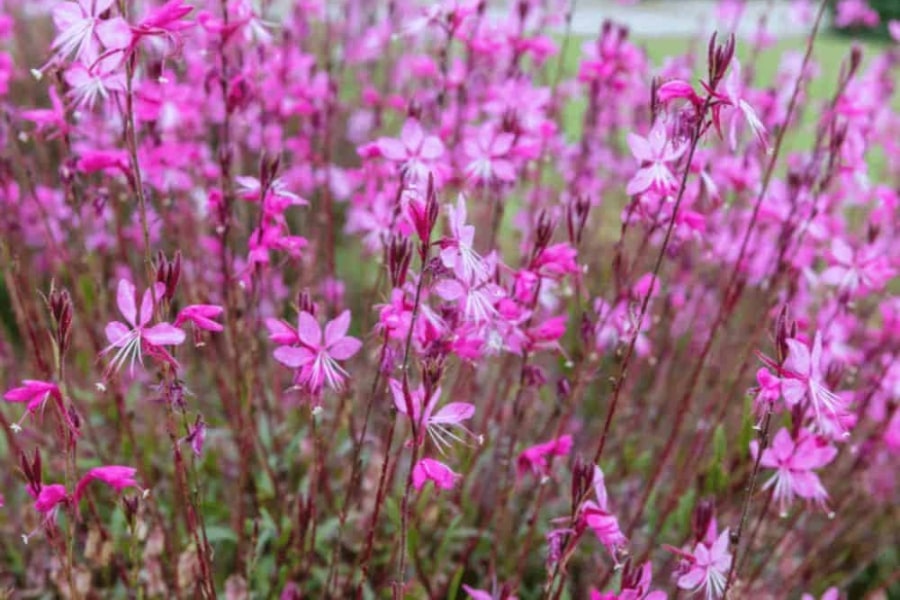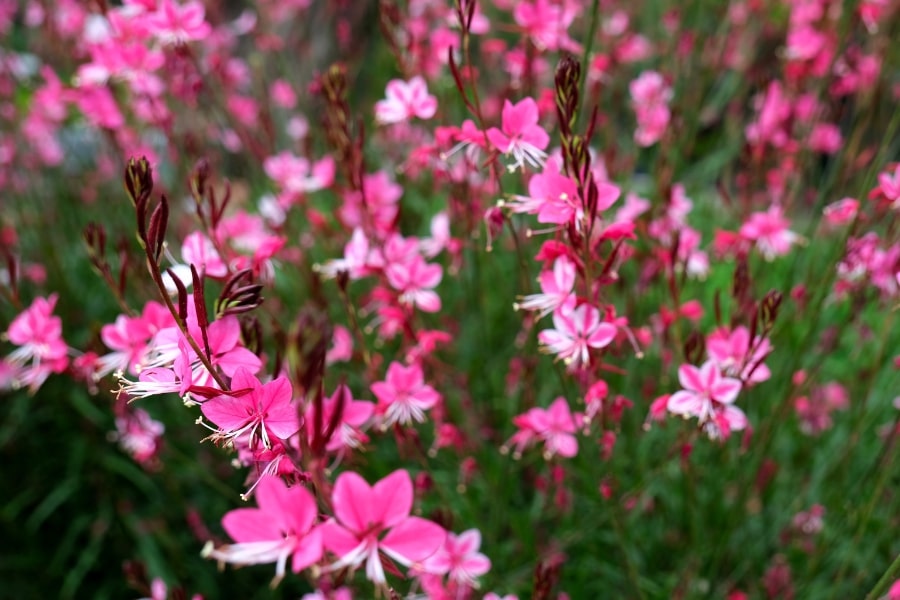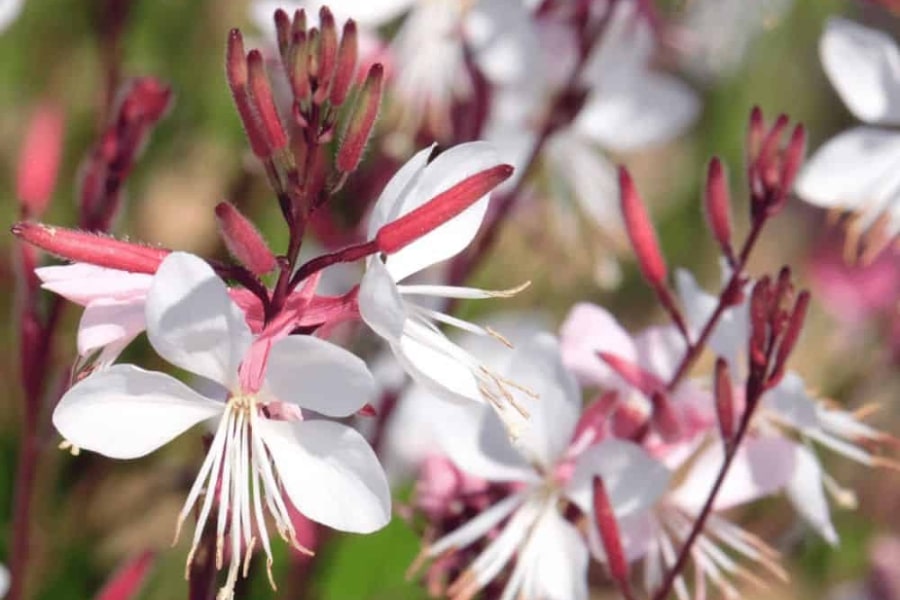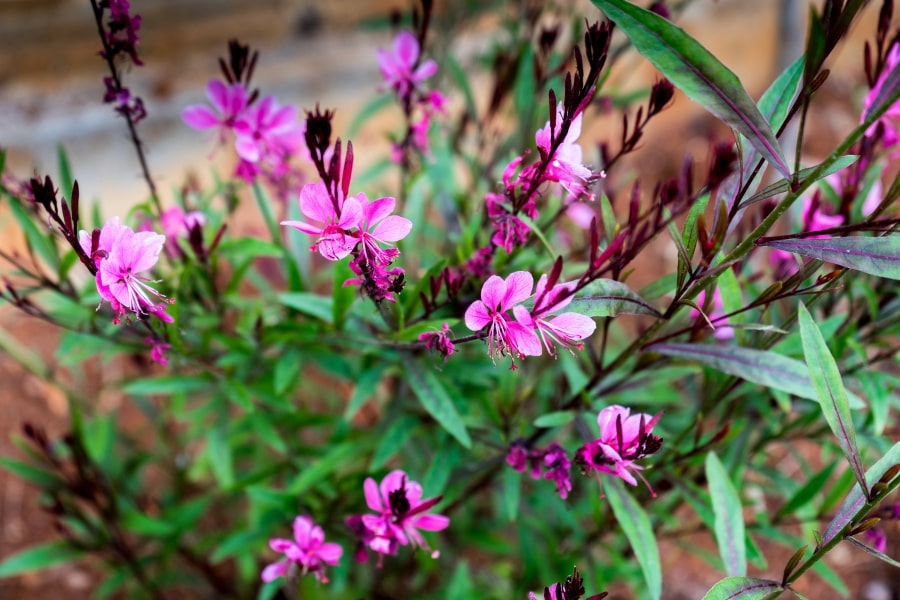Graceful and airy in every sense, Gaura brings a sense of natural grace to the garden that few plants can match. Also known as Beeblossom, this North and South American native belongs to the evening primrose family (Onagraceae) and is celebrated for its airy form and cloudlike sprays of blooms that dance on slender stems. Each flower opens in soft shades of white or pink, resembling tiny butterflies fluttering in the breeze from spring through fall. With over 20 known species—most notably Gaura lindheimeri—these perennials typically stand 2 to 4 feet tall with a gentle 3-foot spread, creating an ethereal, meadowlike presence.

Our Selection of Gaura
At Martin Garden Center, we try to have 4″ pots of Gaura stocked year round. Some of the common varieties we carry include Whirling Butterflies, Siskiyou Pink, Belleza series, and one of our personal favorites, Passionate Rainbow. We also carry 1-gal Gaura from time to time.
We are growing the following varieties in 2025:
Growing and Caring For Gaura
Plant young Gaura transplants or seeds in spring after the last frost. Space them according to the specific variety, typically between 18 to 24 inches apart. Proper spacing encourages the development of the characteristic arching stems and delicate, wand-like flowers. Water the plants thoroughly after planting to help them establish a strong root system.
Gaura thrives in full sun exposure, soaking in the sun’s radiance for a minimum of six to eight hours daily. Sunlight fuels its growth and enhances its prolific flowering, resulting in a mesmerizing display of blossoms that seem to dance upon the breeze.
Well-draining soil is also paramount for Gaura’s success, mimicking the gravelly or sandy soils found in its natural habitat. Adding organic matter like compost during planting contributes to soil structure and aids in moisture regulation, promoting optimal conditions for Gaura’s root development. While it can tolerate a range of soil compositions, Gaura thrives when the pH hovers around neutral.
While Gaura is drought-tolerant once established, consistent moisture during the initial growth phase is crucial. Water the plants regularly, especially during dry spells, and allow the soil to dry between waterings. Be cautious not to overwater, as Gaura is susceptible to root rot in soggy conditions. Applying a layer of mulch around the plants helps retain soil moisture, suppress weeds, and regulate soil temperature.
To prolong blooming and maintain a tidy appearance, deadhead spent flowers regularly. This encourages continuous flowering and prevents the plant from directing energy into seed production. Additionally, Gaura benefits from occasional pruning to control its height and shape. Prune back one-third of the stems in late spring or early summer to encourage bushier growth and more abundant blooms. Gaura is generally not a heavy feeder, but applying a balanced, slow-release fertilizer in early spring can promote healthy growth. Avoid excessive fertilization, as Gaura prefers lean soil.
Gaura is generally not a heavy feeder, but applying a balanced, slow-release fertilizer in early spring can promote healthy growth. Avoid excessive fertilization, as Gaura prefers lean soil. Throughout the growing season, monitor the plants for any signs of pests or diseases, such as aphids or powdery mildew. While Gaura is relatively resistant, prompt action with appropriate treatments, such as insecticidal soap or neem oil, can address potential issues.

Leaves and Flowers
Their leaves are typically long and narrow and are arranged alternately along the stem. They are generally green, lance-shaped, and can vary in texture from smooth to slightly hairy.
These plants are best known for their showy flowers, which bloom from late spring to early fall. The flowers are borne on long, thin stalks that rise above the foliage in loose clusters. The individual flowers are small, four-petaled, and can be white or pink. The long, tubular flowers of Gaura are well-suited to the feeding habits of these insects, and their open structure makes them easy to access.

Uses in the Garden
Gaura is a graceful, airy perennial that brings movement and elegance with its delicate, butterfly-like flowers. Its loose, billowy growth habit makes it perfect for softening the edges of pathways or filling gaps in mixed plantings. Gaura is also an excellent choice for rock gardens and xeriscapes, as it tolerates heat, drought, and poor soil conditions with ease. When planted in groups, it creates a stunning, naturalistic effect, with its long stems swaying gracefully in the breeze.
For a dynamic garden display, consider pairing Gaura with low-growing companions like sedum or coreopsis to contrast its height and airy form. It also works well in containers, where its fine foliage and continuous blooms add a light, whimsical touch throughout the season. Because Gaura self-seeds lightly, it can naturalize in a garden, adding a charming, slightly untamed quality to informal plantings.

Frequently Asked Questions
Is Gaura Deer Resistant?
Deer tend to avoid plants with strong fragrances, fuzzy or tough foliage, and those that are toxic or unpalatable. Gaura’s slender stems, delicate, lance-shaped leaves, and overall texture and appearance contribute to its deer-resistant qualities.
Does Gaura Self Seed?
Yes, Gaura is known for its ability to self-seed. The plant produces small, capsule-like fruits that contain seeds. As these capsules mature and dry, they split open, releasing the seeds into the surrounding soil.
Is Gaura Invasive?
While Gaura has the ability to self-seed and spread, it is not known for aggressive or uncontrollable growth. In fact, many gardeners appreciate Gaura for its graceful appearance and its ability to fill in spaces without becoming invasive.
